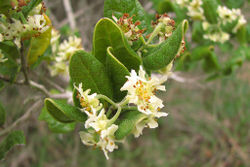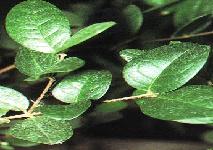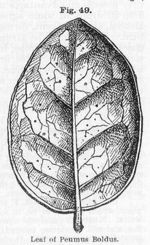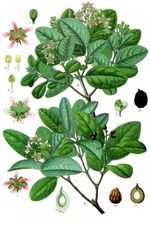Boldo
| Boldo |
|---|

|
| Scientific Classification |
|
| Binomial Name |
|
Peumus boldus |
| Peumus boldus leaves |
Boldo is a species of evergreen tree known by the scientific name Peumus boldus. It is native in central Chile and Peru, and is best known for its many medicinal uses, such as to treat indigestion, stomach cramps (spasms), and mild gallbladder and liver problems. It’s even sometimes used to treat appetite loss and constipation.[2]
Body Design
The Peumus boldus is an evergreen tree that grows at a slow pace; it will get up to 6m (19ft 8in). In Fall the tree is active throughout the year, being in flower from August to September and in leaf the rest of the year. The individual flowers on the tree are either male or female, but never both on the same tree. So if the plant is to be pollinated, both male and female plants must be planted in close range to each other, so pollination is easily accessible. This plant is not self-fertile. [3]
On the female tree, the fruit that is produced is edible and has medical properties. But on the downside, it’s very hard to germinate. It may take up to 180 days to get just a few percent of germination. On average, the germination is 30-60%. The flowers are yellow and white. This is a tough plant, it can tolerate low temperatures up to -8C and can even handle a snow covering for a couple of weeks. But for the plant to be happy for it to thrive, it likes to be fully exposed to the sun. [4]
Life Cycle
The Pleumus boldus is categorized as a perennial tree and grows over 40 feet tall (12 M). When planting, you should space this plant so that it’s always in direct sunlight. This full sun exposure will help in the growing process. There is no danger in planting this plant. The only danger in using this plant is to make sure for you to use it correctly and consult with your doctor about or before any use. The planting process and life cycle for this plant is simple, it starts off as a seed and grows from there. When the boldo is in its tree stage, you may notice pretty flowers blooming on it in the early spring. Actually the flowers don’t only bloom in the early spring but also in the late winter, mid spring and mid winter. So for about half a year you will have beautiful flowers on your tree. If you don’t have a tree in your yard, you may not know the colors of the flowers. Well they include of white to near white and cream to a tan color, which has pretty basic colors. Bees, butterflies, and birds will attract to these flowers, so you may want to be prepared for that. But all in all this plant has a very easy life cycle and will reproduce itself so it can grow again and again. [5]
Ecology
This tree is native to the country of Chile. It likes to live in a medium altitude up to the timber line, and in a low altitude in the interior valleys. In the mountains it can survive in attitudes up to 500-2000m and in coastal areas from 0-500 m. When it comes to weather this plant likes, it’s not picky. From humid areas with constant rainfall, to dry areas this plant can survive. Of course water it mandatory for survival, so in the dryer areas, the tree may only last a month.
This tree really likes to face north, so it can soak up the sun. But if you were to put it in the shade, protection from direct sunlight, some shadow from vegetation, the filtering rate would be up to about 20-40%. This tree typically can withstand any climate and still survive. [6]
Medicinal Uses
The Boldo plant also has many medicinal uses. It grows in Latin America, in countries such as, Chile, Argentina, Ecuador, Bolivia and Peru. The traditional medical uses for this plant were to treat gout, and diseases in the bladder and prostate area. The leaves are made into extracts for treating many dyspeptic disorders. The isochinilinici Boldo contains alkaloids including the most important, Boldin. Boldin is the substance present in the leaves and not so much in the bark of the plant. Bold is used as a modern herbal medicine for the treatment of low-mild hepatobiliary dysfunction, in the treatment of dyspeptic disorders and also in the treatment of constipation. Boldin is responsible for the sedative effect of Boldo. The Bold can be taken in capsules, tablets, as a tea, tincture, and fluid extract. If you are taking it as a tea, the recommended dosage would be 2-5 grams per day. Your treatment with this plant should not in any case exceed over four weeks. An overdose of Boldo can produce vomiting and gastrointestinal pain. Warning: do not take this produce if you are pregnant, may become pregnant, have gallstones, billiard obstruction, or lactation problems. [7]
You shouldn’t take this herbal remedy if you have the following health problems: severe liver disease, gallstones, diabetes, alcohol dependence and if you are pregnant, or if you might become pregnant. If you want to use this product, make sure you tell your doctor or pharmacist about all your nonprescription medications and prescriptions you may use. If you overdose on this product, contact your local poison control center or emergency room immediately. If you live in Canada you should locate or call a local poison control center directly. If you happen to miss one of your doses, don’t worry, just take it as soon as you remember. But don't double dose to catch up! Storing this product is easy; all you have to do is store it in its original package. The Peumus boldus is native in central Chile and Peru. [8]
References
- ↑ Anderson, Kat. Peumus boldus Molina boldo United States Department of Agriculture. Web. 05/19/2013.
- ↑ Lee, Dennis. boldo (Peumus boldus)-oral “MedicineNet.com”. Web. May 26, 2013.
- ↑ Molina. Peumus boldus - Molina. Plants For A Future.Web. 05-19-13.
- ↑ Belov, Michail. Image of Peumus boldus chileflora.com.Web. 5-19-13.
- ↑ Unknown. Author Peumus boldus “Dave’s Garden”.Web. 05-26-13.
- ↑ Image of Peumus boldus chileflora.com.Web. 5-19-13.
- ↑ Hunch, Fred. Medicinal Uses of Boldo “HubPages”. Web. 05-24-13.
- ↑ Lee, Dennis. boldo (Peumus boldus)-oral “MedicineNet.com”. Web. May 26, 2013.



